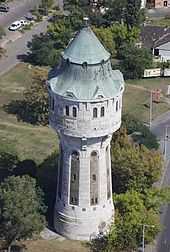Újpest
| Budapest - Újpest | |
|---|---|
| District | |
 | |
| Country | Hungary |
| Region | Central Hungary |
| County | Budapest |
| Government | |
| • Mayor | Zsolt Wintermantel (Fidesz-KDNP) |
| Area | |
| • Total | 18.82 km2 (7.27 sq mi) |
| Population | |
| • Total | 98,381 |
| • Density | 5,227.5/km2 (13,539/sq mi) |
| Time zone | CET (UTC+1) |
| • Summer (DST) | CEST (UTC+2) |
Újpest (German: Neu-Pest, English: New Pest)[1][2] is the 4th District in Budapest, Hungary. It is located on the left bank of the Danube River. The name Újpest means "new Pest" because the city was formed on the border of the city of Pest, Hungary in 1838.[2] Újpest was a village for 6 decades until 1907 when it became a town. In 1950, the town was unified with Budapest to form Greater Budapest. Since 1950, Újpest is the 4th District of Budapest.
The football club Újpest FC is named after the area, since they were formed in the district in 1885, and have played there since.
District
The district is composed of six parts. Újpest is the largest, but the district also includes Megyer, Káposztásmegyer, Istvántelek, Székesdűlő and the northern tip of the island Népsziget.[3]
History
Isaac Lowy owned a shoe factory that he wanted to move to Pest but was unable to attain a settlement permit because he was Jewish.[1] In 1835, he decided to create a new town where he would build the factory.[1] North of Pest, there was an empty tract of land that was owned by the Károlyi nobles.[1] Lowy bought the land; the deed included the right of religious freedom, the right to self-government, and the right to engage in business.[1] By 1838, 13 Jewish families lived in Újpest; soon thereafter Christians began moving in.[2]
Famous statues, like Wesselényi Monument, Matthias Corvinus Monument, were cast in bronze by the workshops of Alexander Matthias Beschorner from Újpest.
Twin towns
Újpest is twinned with:
Famous residents
- Julies Dessauer (born 1832), rabbi and writer.[4]
- Lipa Goldman (born 1905) chief rabbi of the Orthodox Jewish Community.[5]
- Yosef Goldman scholar and bookdealer.[6]
- Olivér Halassy (1909–1946), water polo player and freestyle swimmer.[7]
- Isaac Lowy (1793–1847), Hungarian industrialist and founder of Újpest.[1][2]
- Alexander Rado (1899–1981), Soviet spy.[8]
- Ferenc Szusza[9]
- Ludwig Venetianer (1867–1922), rabbi and writer.[10]
Gallery
-

Megyeri bridge
-

Ramada Resort Aquaworld
-

Ute stadion
-

Town Hall
-

Water tower
-

Parihs
See also
- List of districts in Budapest
- Ujpest Synagogue
References
- ↑ 1.0 1.1 1.2 1.3 1.4 1.5 Patai, Raphael (1996). The Jews of Hungary. 265: Wayne State University Press. p. 730. ISBN 978-0-8143-2561-2.
- ↑ 2.0 2.1 2.2 2.3 Valley, Eli (1999). The Great Jewish Cities of Central and Eastern Europe: A Travel Guide and Resource Book to Prague, Warsaw, Crakow, and Budapest. Jason Aronson. p. 538. ISBN 0-7657-6000-2.
- ↑ Tamás S Kiss. "Workers' town revisited". Budapest Sun. Retrieved 2008-01-03.
- ↑ Meyer Kayserling. "Julies Dessauer". Jewish Encyclopedia. Retrieved 2008-01-03.
- ↑ Jack Roth (1949-04-06). "DP Rabbi, Family Dock, Full of Joy". The New York Times. Retrieved 2008-03-11.
- ↑ Yitzchak Levine (2006-12-06). "Hooked On American Jewish History". Jewish Press. Retrieved 2008-01-03.
- ↑ profile (Hungarian). Retrieved on 2008-01-03.
- ↑ Alexander Rado, Central Intelligence Agency. Retrieved on 2008-01-03
- ↑ Ferenc Szusza, imdb.com. Retrieved on 2008-01-03.
- ↑ Isidore Singer. "Ludwig Venetianer". Jewish Encyclopedia. Retrieved 2008-01-03.
External links
Coordinates: 47°34′N 19°05′E / 47.567°N 19.083°E
| |||||||
